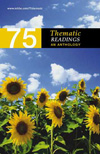
Langston Hughes |  |
Langston HughesLangston Hughes, "Salvation" Langston Hughes (1902-1967) was born in Joplin, Missouri. He lived in
Kansas, Illinois, and Ohio before studying at Columbia University and
earning an A.B. from Lincoln University in 1929. Hughes, a prolific writer,
wrote poetry, plays, songs, fiction, and nonfiction. Much of Hughes's
writing offers a transcription of urban life through a portrayal of the
speech, habits, attitudes, and feelings of an oppressed people. His work
does more, however, than reveal the pain of poverty—it also illustrates
racial pride and dignity. Hughes's many books include the poetry collection
Montage of a Dream Deferred (1951), the novel Tambourines to
Glory (1958), the short-story collection The Ways of White Folks
(1934), and the nonfiction work Black Misery (1969). Among his
many awards and honors, Hughes won a Guggenheim fellowship and an Anisfeld-Wolfe
Award. Hughes died of a heart attack in New York City. "Salvation"
is taken from Hughes's autobiography, The Big Sea (1940). | QUESTIONS FOR DISCUSSION | CONTENT - How old is the author in this recollection?
- Who is Westley, and how does he react during the ceremony?
- Describe the preacher's sermon.
- During the sermon, what is the author waiting for? What is the basis
of his misunderstanding?
- Why does Hughes ultimately go up to the altar? How does the congregation
react?
- Why does Hughes cry when he gets back to his room? How does his aunt
react?
STRATEGY AND STYLE - "Salvation" is a narration about a part of one specific
man's life, but it has widespread significance. What are some of the
ways Hughes makes this more than just the story of a single individual?
Where in the essay did you go to support your answer?
- Examine the repeated use of exclamation marks in paragraph two. From
whose voice do these words seem to be coming? Could it be from more
than one voice? Explain. How could the author have presented this information
differently? What would be lost?
- How can the title of this essay be seen as ironic? What salvation
occurs?
- Hughes uses three paragraphs that are each only one sentence long.
Find them and answer these questions: What is the impact of such a stylistic
decision? How can you relate these sentences to the feelings the young
Hughes was going through in the church?
| ENGAGING THE TEXT | - Do you feel more comfortable in big cities, in the suburbs, or in
rural areas? Does the type of demographic setting matter to you, or
are you equally comfortable anywhere? How might your feelings in this
regard have affected your reading here?
- Do you go to church regularly? If so, which church? If not, why not?
How might your answers here have interacted with your experience of
reading this essay?
| SUGGESTIONS FOR SUSTAINED WRITING | - Trace the juxtaposition of young and old in this essay, and write
about your findings. Is the narrator in a privileged position in this
regard?
- Write a piece of your own personal history when you were nearly thirteen,
centering around one very important moment, religious or otherwise.
Can you relate any of your experience to the author's? What's different?
| FOR FURTHER RESEARCH | "Salvation" takes place in the rural Midwest, just about at
the start of World War I. Do some research about revival meetings and
preaching going on at that time in that area. How did your research project
deepen your understanding of the essay? | WEB CONNECTION | To put Hughes into a historical context you have to become familiar with
the history of Harlem. Here is a timeline
with photos of Harlem in the first half of the last century. It's a good
place to start your historical journey. | LINKS | Biographical Looking for a great starting point to research Hughes online? Here
is Hughes's
page at the American Academy of Poets site, where you'll find biographical
information, a photograph, a bibliography, and several Hughes related
links. Doing a research paper on Hughes? Looking for more information? Here's
a biography
of Hughes from the University of Kansas that goes into greater detail
than the one above. You'll find some good links there, too. Here's a photo
of Hughes from the Smithsonian, taken in 1939 by Carl Van Vetchen, an
early champion of the Harlem Renaissance. Vetchen was prominent in the
white literary establishment at the time this photograph was made.
Bibliographical Here is Hughes's influential poem "Dream
Deferred" in etext. Can you find the phrase A Raisin in
the Sun anywhere else online? Here are "Jazzonia"
online and some related links. Can you think of connections between
Hughes's poetry and music? For further reading here are "Justice"
and "Still Here" in etext. How are they thematically similar
to the work found in your textbook? How are they different?
Cultural If you'd like more on the social history of Harlem in this era,
here is a tour
of "Harlem After Dark" in the 1920s. The artistic movement Hughes was most closely associated with is called
the Harlem Renaissance. (He was sometimes called the "poet laureate
of Harlem.") Want an online introduction? Here's an overview
of the Harlem Renaissance. The prominent figures of the Harlem Renaissance were not exclusively
men. These links
featuring women active in the Harlem Renaissance will help complete
your understanding of the movement.
|
|
|
|